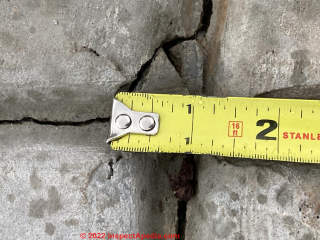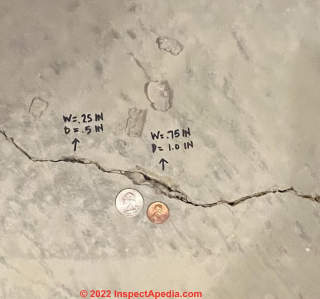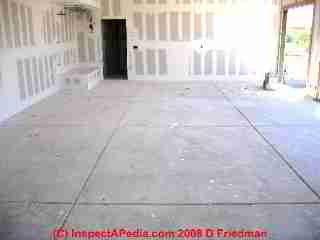 How to Evaluate Cracks at Control Joints in Concrete Floors & Slabs
How to Evaluate Cracks at Control Joints in Concrete Floors & Slabs
- POST a QUESTION or COMMENT about concrete slab cracks at or near control joints
Concrete slab cracks at control joints:
This article describes the causes, evaluation, and repair of cracks at control joints in poured concrete slabs or floors.
Are cracks at control joints or expansion joints in concrete a problem? Are control joints always needed in poured concrete? Recommended methods for sealing cracks in concrete floors & slabs
This article series describes how to recognize and diagnose various types of foundation failure or damage, such as foundation cracks, masonry foundation crack patterns, and moving, leaning, bulging, or bowing building foundation walls.
InspectAPedia tolerates no conflicts of interest. We have no relationship with advertisers, products, or services discussed at this website.
How to Use & Inspect Control Joints in Poured Concrete Slabs
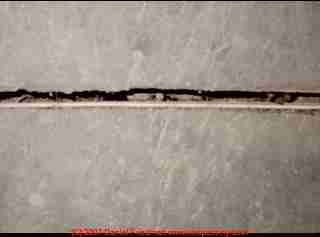 Here we focus on control joints needed in poured concrete floor slabs and monolithic concrete foundations. But control joints are also required in certain masonry walls, including brick walls and in some cases concrete block walls as well as poured concrete walls.
Here we focus on control joints needed in poured concrete floor slabs and monolithic concrete foundations. But control joints are also required in certain masonry walls, including brick walls and in some cases concrete block walls as well as poured concrete walls.
See BRICK WALL THERMAL EXPANSION CRACKS
Separately at CONCRETE SLAB CRACK EVALUATION we catalog the different types of cracks that show up in poured concrete.
What is a concrete slab control joint & why do we need control joints in concrete?
A control joint controls where and how a shrinkage crack appears in poured concrete, and it allows for thermal expansion or contraction without additional damage.
Without a control joint, cracks in concrete floors, walls, or ceilings appear at stress points in uneven, diagonal, or other patterns in locations where they may be unsightly or may cause damage such as cracks in ceramic tile or other floor coverings, or may be traced to leaks.
How much does concrete shrink as it cures? How much does concrete move in response to temperature changes?
Because concrete shrinks as it cures (about 1/16 inch for each 10 linear feet or by other sources, about .66 inches per 100 feet), and because there may also be some expansion and contraction of poured concrete in response to temperature (about 0.25 inches per 100 feet per 25 degF temperature change, with a maximum of about 0.5" per 100 feet) and moisture changes in its environment, a large solid slab of poured concrete for a floor or slab is likely to crack.
Also see TEMPERATURE EFFECT on CONCRETE POUR
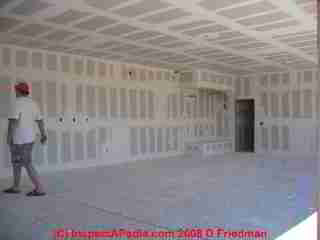 Control joints, called "relief joints" by some builders and more loosely speaking, "expansion joints" by others, are built into a well-designed poured
concrete slab so that the occurrence of more random, ugly cracks is less likely.
Control joints, called "relief joints" by some builders and more loosely speaking, "expansion joints" by others, are built into a well-designed poured
concrete slab so that the occurrence of more random, ugly cracks is less likely.
Remember that concrete shrinkage itself is a normal process. If a pour and control joints are perfect, cracks caused by concrete shrinkage will not be noticeable - they'll occur inside the control joints (as we show below), or if a slab shrinks perfectly with no internal cracks, you'll see a gap opening around the perimeter of the slab where it abuts the foundation walls.
Description of the concrete curing process
During the concrete curing process, a chemical process called hydration, concrete hardens, using some of the water molecules in its original content.
Concrete typically takes 28 days to reach its design strength; a considerable portion of concrete shrinkage is going to occur during this interval, particularly during the first week or less.
Even though the concrete's design strength is reached in about a month, concrete continues to harden for days or weeks after that point too.
What do control joints or "expansion joints" look like?
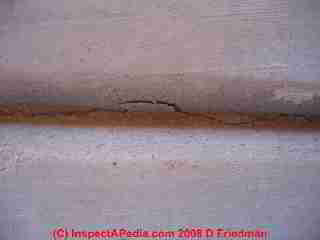 A control joint is a gap, usually formed in a straight line, placed at intervals to control where and how cracks will occur in poured concrete. When you see a "crack" or joint that is formed in a straight line, dividing poured concrete into sections, most likely it's a control joint.
A control joint is a gap, usually formed in a straight line, placed at intervals to control where and how cracks will occur in poured concrete. When you see a "crack" or joint that is formed in a straight line, dividing poured concrete into sections, most likely it's a control joint.
Concrete control joints may also be cut by a power saw if they were omitted during the original pour.
In the photo at left is a tooled control joint in a concrete floor slab.
A concrete control joint that was formed during the pour or placement of the concrete usually is tooled to round the upper edges of either side of the joint, and the joint extends some depth into the concrete, or in some cases (such as sidewalks and some floors) the control joint may extend through the full depth or thickness of the concrete. Full-depth control joints are normally filled with a flexible material.
The photograph at page top and the photo just above where Andy is walking away from the camera show expansion joints in a garage floor slab in Arizona.
Even in a climate where we do not anticipate freezing, control joints are needed to prevent random shrinkage cracks that would otherwise occur in a large concrete floor slab pour like this one. Notice that we do not see other cracks in this slab.
Control joints are likely to appear as straight lines at regular intervals across a poured concrete slab (if they were used in the construction of the slab) such as we show in the sketch below, at the lines marked (G) at 4' intervals or larger depending on the concrete materials and slab design used.
Close-up Photos Reveal Concrete Shrinkage Cracks Within the Control Joint
Shrinkage cracks that occur at control joints such as shown in the pair of close up concrete slab control joint crack photos here, are occurring where they are supposed-to.
The fine crack shown in the photo of a concrete slab control joint (just above) is normal - this crack would have occurred in a random pattern instead of along the control joint if this floor slab (the same floor shown at the top of this page) had been poured without any control joints.
In a different building, the width of the control joint crack in the photo below was surprisingly large.
These cracks are not normally a defect in the slab but may be a source of water or radon gas entry into the building and may need to be sealed.
Frost Damage Can Cause Damage Exceeding the Capability of Concrete Control Joints
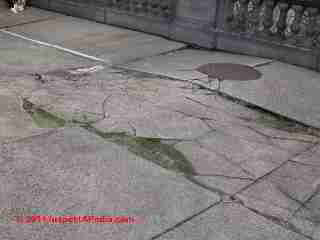
Uneven, heaved concrete: If if concrete surface of the floor or slab or sidewalk on either side of an apparent "shrinkage crack" in a concrete surface is at two different heights, forces other than simple concrete shrinkage are at work.
In this photo the outdoor slab has been heaved by frost, probably exacerbated by wet soils and perhaps poor drainage below the poured concrete.
Notice the steel manhole in this photo. Our first guess was that a buried sewer drain became clogged, stopped, and frozen, causing the ground (and concrete) to heave along the path of this pipe.
We sometimes find this concrete floor failure pattern in basements of homes built in freezing climates if the home has been left un-heated during freezing winter. If your concrete slab or sidewalk cracks look like this, you should review the text at the following diagnostic articles:
- FROST HEAVE/EXPANSIVE SOIL CRACKS IN SLABS
- SETTLEMENT CRACKS VS. FROST HEAVES
- SETTLEMENT CRACKS VS. SHRINKAGE CRACKS
- STANDARDS FOR REPAIR OF CRACKS IN FLOORS since further repair or other actions may be needed.
How are poured concrete slab control joints made?
The mason who is pouring a slab greater than twenty feet in any direction has to prepare the site for the pour, including the provision of control joints in the slab when its concrete forms are being placed or else during the pour itself.
An individual control joint is made by inserting a flexible material (plastic or in the old days, jute or strips of Homasote™) which is 1/4" to 1/2' in thickness (width) and which runs the length of the control joint.
The same material may be placed around the perimeter of a floating slab where it contacts the perimeter of an existing building foundation wall. Similar control joints are often used where a concrete sidewalk abuts a building or other structure.
Methods for providing control joints in concrete slabs
- Flexible joint inserts
in poured concrete floors or slabs, using 1/4" to 1/2" thick flexible control joint material - V-tool trowel
can be used to score a groove in the still flexible poured concrete floor or slab before it has fully hardened, creating a pre-defined and straight "weakened" point in the slab which invites shrinkage cracks or other cracks to occur at that location.
The depth of the "vee" cut by this trowel is much less than the thickness of the concrete slab, running from about 3/16" to 1" in depth of cut. - Sawn control joints
are cut into a cured and hard poured concrete slab (and into other masonry surfaces) after the concrete (or other masonry) has hardened. We've recommended this approach (along with other repairs) where we found destructive thermal expansion of large brick masonry walls that were constructed without expansion joints.
Sawn control joints are normally filled or partly filled with a special caulk or masonry sealer (described below).
The page top photograph above shows an outdoor poured concrete slab that had control joints or something that looked like them. Even the best control joints were no match for having poured this concrete over episodically wet, frost-heaving soil.
Only by providing excellent drainage would the cracking and heaving visible in this photo have been avoided.
How deep and wide should a concrete control joint be? At what intervals should we place control joints in concrete slabs?
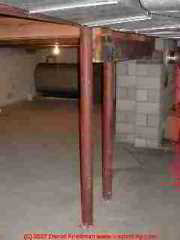
The width of a concrete slab control joint
is the same as the control joint insert (1/4' to 1/2" in width) or of the vee-trowel (about 3/8" wide), or
of the saw blade used to make the cut after the concrete has hardened - typically about 1/8". In concrete roof slabs using lightweight concrete such as Perlite(R), control joints
may be specified at a much wider thickness of 1" around roof penetrations like stairways and skylights.
This is because a rooftop is exposed to wider temperature swings than indoor building areas such as a basement floor slab.
The depth of a concrete slab control joint
should be equal to one fourth of the thickness of the slab, or deeper. So a six inch thick poured
concrete floor would use control joints of about 1.5" in depth.
You'll notice that this is deeper than the depth provided by the "vee trowel" discussed above. A vee trowel is more commonly used to make pseudo-control joints in concrete sidewalks.
The spacing interval for control joints in a slab
varies depending on the kind of slab (monolithic slab foundation, floating slab floor inside an existing foundation, sidewalk, vehicle pavement),
the dimensions of the slab, the kind of concrete being poured (perhaps containing crack-resisting fibers), and the presence of other reinforcing
materials (steel re-bar or steel mesh).
Do Cracks Ever Occur Out of the Control Joints in Poured Concrete?
Cracks in poured concrete can indeed occur out of a control joint. Reasons for this bad behavior might include deficiencies in the concrete mix or curing conditions that cause shrinkage forces to occur in locations between control joints and in spite of them.
An example is shown in this photograph of a small (and insignificant) concrete shrinkage crack that occurred at the intersection of several control joints in a floor slab.
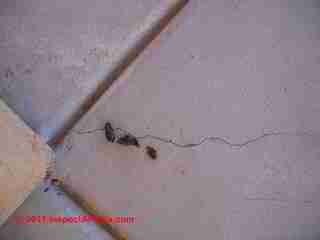 Perhaps the worker did not cut the control joints deep enough in this location where we see the intersection of four
control joints, or other forces may have been at work.
Perhaps the worker did not cut the control joints deep enough in this location where we see the intersection of four
control joints, or other forces may have been at work.
Still, at the end of the day, you can expect far less cosmetic or other more problematic cracks in a poured slab if control joints are installed at the proper interval and proper depth.
Are Control Joints Absolutely Necessary in Poured Concrete Slabs?
Strictly speaking, perhaps not. Some builders and masonry contractors use concrete which contains reinforcing fibers or other additives intended to reduce slab cracking, and indeed to be fair, we've inspected some large slabs that had no control joints, and in which we did not see shrinkage cracking.
But based on having inspected quite a few pours with and without anti-cracking-additives, our opinion remains that best practice is to always include properly-spaced and properly-designed control joints in a slab or concrete floor concrete pour in residential buildings.
- Thanks to Jay Hodgens, P.E. for technical edits.
Control Joints in Concrete: Cutting Details
Reader Question: timing & depth of concrete slab control joint cuts
(July 29, 2014) M fetter said: [paraphrases] Can you tell me when following the concrete pour or placement the control joints should be cut? And can you tell me the required control joint cut depth in a concrete slab?
Reply:
M.F. Control joints are often provided-for in the placement of concrete by installing control joint materials at the time that the forms are set and before the pour.
However if after a concrete pour the engineer determines that control joints need to be added in a slab, they can be cut using a concrete saw.
Those cuts are usually not attempted until the concrete has cured sufficiently to be undamaged by both the foot traffic and the operation of the concrete saw.
In my own (limited) experience, cutting a poured concrete slab immediately after it can be walked-on risks breakage of the slab at the cut edges. A typical standard would require 16 hours of set time between poured free jointed slab sections (see below).
Branz, a New Zealand construction research firm offers additional helpful details about concrete slab pouring and concrete control joints (as do many other sources).
Concrete Slab Shrinkage Time
Concrete will continue to shrink over at least the first 12 months after it has been poured, with about half of the shrinkage occurring in the first 4 months.
Spacing Requirements for Control Joints in Poured Concrete
NZS 3604:1999 and similar standards require control joints such that no individual poured concrete slab section is larger than 24m in any direction. If the slab is reinforced using #668 mesh then the maximum concrete slab section or "bay" should not be larger than 12m x 12m. - Branz (2005)
A "Free Joint" in a concrete slab is a construction joint that has no reinforcement (such as re-bar) passing through it.
When a free joint is formed by making separate pours of concrete then at least 16 hours should be allowed between the pours, allowing the side of the joint in the first pour to cure or "harden" for that interval.
Timing of Cutting Add-on Concrete Slab Control Joints
Branz (2005) advises that in summer weather control joint cuts should be made within 24-hours of the initial concrete pour while in winter the control joint cuts should be made within 48 hours of the concrete pour.
I presume that this timing is in part to reduce the chances of uncontrolled shrinkage cracks appearing elsewhere in the slab.
Depth of Concrete Control Joint Cuts
When cutting a retrofit control joint in an existing poured concrete slab, an approach that can speed the whole construction process (by allowing larger slab area pours), the cut depth should be half the thickness of the slab and at least deep enough thorough the slab that any steel reinforcement that would have spanned the cut is also cut through.
Control Joint Alignment Controls
Branz describes four approaches to control joint alignment management:
- A tongue and groove design aligns the edges of independent pours.
- A pre-constructed (presumably with flexible insert) control joint in slabs whose re-bar or steel reinforcement is stopped several inches from the edges of each slab bay
- Dowel pinning between abutting slab sections: the dowel is set in the first pour and projects into the area where the second slab bay will be poured. The exposed dowel surfaces are covered with a flexible material to provide a separator coating.
- A 5 mm cut is made through at least half of the thickness of a poured slab, deep enough to cut any steel reinforcement. - (Branz 2005)
Watch out: do not lay ceramic tiles across control joints as movement there is likely to cause cracking in the filed finish-floor .
- Branz Corporation, "Concrete Slabs and Control Joints", Build, Aug/Sept 2005, Branz, Moonshine Road, Judgeford, Porirua City 5381, New Zealand
Post: Private Bag 50 908, Porirua 5240, New Zealand
Phone: +64 4 237 1170
Fax: +64 4 237 1171
Email: branz@branz.co.nz
Publication sales: publicationsales@branz.co.nz , Tel: Professionals helpline - 0800 80 80 85
- is available free to those who work within the New Zealand building and construction industry. Tel: consumer helpline is 0900 5 90 90. Calls cost $1.99 per minute, plus GST. Quoting: BRANZ is an independent and impartial research, testing, consulting and information company providing resources for the building industry.
Reader Comments, Questions & Answers About The Article Above
Below you will find questions and answers previously posted on this page at its page bottom reader comment box.
Reader Q&A - also see RECOMMENDED ARTICLES & FAQs
On 2022-07-21 by InspectApedia-911 (mod) - crack about 1/16" to maybe 3/32" wide is not abnormal in a control joint
@Anonymous,
In your photo we don't see signs of a bad concrete mix and crumbling concrete - just breakage from movement as we reviewed before.
I'm reluctant to reach a broad conclusion with so little data - it's like inspecting a building through the eye of a needle.
On 2022-07-21 by Anonymous
@InspectApedia-911, thank you. Should I be concerned about the crumbly concrete? I have the same crumbly concrete in my garage surrounding hairline cracks. From your reply to a different post below, it seems the concrete mixture had too much water perhaps. Is this just mainly a cosmetic concern that I should live with?
On 2022-07-21 by InspectApedia-911 (mod)
@Anonymous,
If we ignore the fracturing it looks as if your crack is about 1/16" to maybe 3/32" wide - not abnormal in a control joint.
As long as the masonry on both sides of the crack is at the same level we don't suspect settlement or other troublesome movement.
I'd leave it alone, but if for cosmetic reasons you want to fill the crack, use a color-matched but flexible sealant.
On 2022-07-21 by Anonymous
Hello sir, is the gap created by the cracking in the control joint in my 6 month old driveway ok to leave as is? I know the control joint is meant to crack, but it seems the gap created by it is rather large. I live in a new townhouse subdivision and none of my neighbors’ driveway has this issue, only normal hairline cracks in the control joints.
Not sure if it’s related, but there are a ton of ants just around this gap. I also see crumbling concrete bits surrounding the crack. If I took those bits out, which is very easily done, the gap would be even larger. I’m under builder warranty and wondering if a fix is necessary for functional reasons (water, bugs, etc) or aesthetic reasons. Thank you for your expertise.
On 2022-01-18 by Inspectapedia Com Moderator - widening of the crack could mean that there is ongoing movement in the slab
@Beth,
Unless there was actual blasting going on at the nearby construction site the causes of crack opening on your floor are likely to be one of those discussed in the Recommended Articles at the end of the article above: settlement, heaving, shrinkage.
And nearby construction would have nothing to do with the original quality of the mix or pour of your concrete slab: if the surface is soft enough to crumble that's a mix issue as I suggested earlier.
I can't see the control joint so can't say that the crack is in a control joint - or not - it looks a bit wobbly and wavy for that term to apply.
Causes of movement in masonry are given in detail in this article series: settlement, frost heaves, expansive clay, thermal movement, and others.
IF there is cyclic movement that often explains fracturing of material within a crack.
On 2022-01-18 by Beth
@Inspectapedia Com Moderator,
Thank you! I noticed the crack worsened over the last 6 months when construction of a new home began next to my home. With my home being 3 years old, would you guesstimate the crack becoming even larger?
On 2022-01-17 by Inspectapedia Com Moderator
@Beth,
Widening of the crack could mean that there is ongoing movement in the slab.
Crumbling at the edges of a concrete slab crack could mean that the pour mix was not proper and the concrete surface is soft.
On 2022-01-17 by Beth
What would cause a control crack on a slab to widen or take on a crumbling appearance in various locations in one section of the control crack?
On 2021-12-08 by Inspectapedia Com Moderator (mod)
@Paul,
I'd try to push the seal back into the joint; only if most of the original control joint has closed completely might I think more action is needed.
On 2021-12-08 by Paul
If the rubber expansion joint separates from one side of the concrete joint after movement as that expansion joint failed and needs to be redone ?
On 2021-11-18 by Inspectapedia Com Moderator - cyclic heaving can show up as jamming doors or windows
@Tricia,
Ask local builders or even your neighbours if your home is built in an area of expansive clay soils - that can explain cyclic heaving that indeed can show up as jamming doors or windows.
Then use the InspectApedia on-page search box to find our article explaining EXPANANSIVE CLAY SOILS - or find that in the Index to Related Articles above on this page
On 2021-11-18 by Tricia
I live in AZ and purchased a two-story home three years ago built in 2001. About two years we started having issues opening our master bedroom door upstairs as it would still in the top left corner (opposite the hinges). A year later, it got worse. Instead of just sanding it down, I called out foundation solutions who resolved that I had very minimal slab movement and needed to have a specific crack fixed and gutters installed.
Got two opinions with both the same overall opinions. Then started seeing floor boards lifting at every connection as well.
Had tech out to fix crack only to find out it was contraction joints cut all over my slabs. I want to say these joints were cut ever 5 to 8 feet. My house is 3200 Sq ft at two stories, I just think these joints are excessive.
About half the joints have been stitched now but lifting upstairs have nor corrected and not sure yet if they will get worse. I am not sure what to do, if I can do anything else to mitigate moving or if I literally have to have someone else come secure down the boards upstairs.
On 2020-09-19 by (mod) - control joints made with a V-tool trowel are cracked open at he bottom
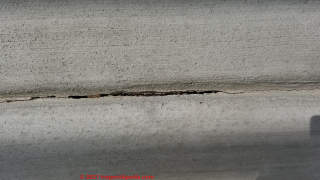 RE-posting from private email:
RE-posting from private email:
L asked: The scored groove control joints that were made with a V-tool trowel are cracked open at he bottom if the control joint. Is that ok? Won't water get underneath the slab and raise it up?
There were no cracks coming from the scored V groove.
The V scored groove itself split apart, like opening up a book. Is this okay? Most all the scored grooves that were made with a V-tool have split down the middle. Is that okay to have a lot of the seams split like that?
Moderator reply:
The control joint is intended to make the cracks - which are pretty much unavoidable - follow the joint. That's to avoid more-random cracks at other locations in the slab;
IF there's a water problem the control joint is not the cause; rather that would be failure to keep water away from the building outside.
On this page you will see photos of other cracks or openings in concrete control joints.
On 2019-10-15 - by (mod) -
Significant water leakage under any paved surface can cause settlement or in an area of expansive clay soils, heaving and settlement cycles; if you face those concerns, these hairline cracks at control joints are not going to be the main influencing factor - after all the entire perimeter of the drive is open to the weather too.
Details of drive construction are pertinent: over fill, over clay alone, over gravel on clay, drained, compacted, subject to or protected from surface runoff?
On 2019-10-15 by Joe
Thanks again. We're in Ga. so no danger of frost damage. That said, if the cracks are not sealed could long term water seepage cause potential soil compaction and wider cracks ? Driveway is built on clay.
Appreciate your feedback
On 2019-10-14 - by (mod) -
There's no benefit to sealing these cracks if you are not seeing frost damage and in my OPINION doing so would look ugly;
IF there were a need to keep water out you'd probably need first to saw the joints open to a wider gap then use a polyurethane sealant; I'd not do it.
On 2019-10-14 by Anonymous - do I need to seal these cracks in the control joint of my concrete?
@Joe,
Appreciate your reply. I attached more pics. When are control joint cracks deemed too wide ? Should they be sealed ? Thanks again. Joe
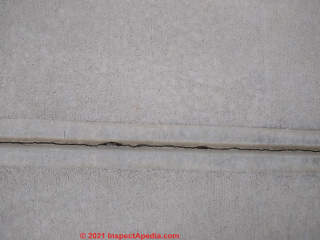
On 2019-10-13 - by (mod) -
Joe
I suspect these are normal shrinkage cracks occurring right where they were supposed-to, at control joints cut into the concrete drive.
A few more photos would help.
On 2019-10-13 by Joe
My driveway is 18 mos. old. The crack control joints have wide gaps within them about 1/4" wide.
What is the best way to identify the cause of such wide cracks ?
Thanks.
Joe
On 2018-11-09 1 by (mod) - proper control joints protect the concrete slab
Karen
As long as the control joints are properly cut after the slab is poured, I would be stunned to hear of a report anywhere claiming that the 9 day delay in creating those control joints created itself any problem in the slab.
The concrete has only barely begun to cure in the first nine days of its life and the stress is continue to develop over a much longer period. Even if there were already stressors in the slab they're relieved by the control joint.
I did some research to see if I could find any expert expressing a different View.
Interestingly in some situations, a seven delay between placement of a new concrete slab and cutting-in of control joints is actually necessary in some cases to permit proper cuts without damaging the slab.
See
this example
Research on Concrete Control Joint Preparation, Methods, Timing
- Chiuminatta, Edward, and Alan R. Chiuminatta. "Apparatus and method for cutting unhardened concrete." U.S. Patent 5,184,597, issued February 9, 1993.
Excerpt:
Conventional practice has been to cut crack control grooves in the concrete as soon as possible, and about 7 days later, to use diamond abrasive water saws to cut over the crack control grooves and form a wider, shallower well into which the sealant is placed.
Since the sealant well is so much wider than the crack control grooves, the concrete must be allowed to become very hard to avoid cracking, chipping, and spalling of the concrete when the 0.25 or 0.375 inch wide groove is cut to form the well for the sealant.
Thus, the seven day delay is often required to insure the concrete is sufficiently hard and will not crack, chip, or spall when the wide groove for the sealant well is cut in the surface of the concrete.
- Gerald F. Voigt, P.E., "Specification Synthesis and Recommendations for Repairing Uncontrolled Cracks that Occur During Concrete Pavement Construction", [PDF] ACPI, Gerald F. Voigt, P.E., Vice President - Technical Operations, American Concrete Pavement Association, 5420 Old Orchard Road, Suite A100, Skokie, IL 60077-1059 USA, Tel: 847-966-2272; Email: gvoigt@pavement.com, retrieved 2018/11/09, original source: 1204075.sites.myregisteredsite.com/Downloads/Cracking.pdf
Also available at inspectapedia.com/structure/Concrete-Slab-Cracking-Repair-Voigt.pdf
Excerpt:
Mixtures containing certain fly ashes or lower quantities of portland cement can delay early age strength development in cooler weather. Depending on the air and concrete temperature, this could delay concrete setting and the ability to saw without excessive raveling.
After setting, the time available for sawing before the onset of cracking may be much shorter than normal. - Armaghani, Jamshid, and Diep Tu. "Rehabilitation of ellaville weigh station with ultrathin whitetopping." Transportation Research Record: Journal of the Transportation Research Board 1654 (1999): 3-11.
- Chiuminatta, Edward, and Alan R. Chiuminatta. "Apparatus and method for cutting unhardened concrete." U.S. Patent 5,507,273, issued April 16, 1996.
- Hanson, Raymond A. "Joint forming apparatus for concrete surfaces." U.S. Patent 3,381,595, issued May 7, 1968.
On 2018-11-08 by KarenKenny
We are in the process of having a home built. The 2100 square foot basement and 1200 square foot garage were poured cut the supervisor forgot to have contraction joints cut until 9 days after the pour.
I know the concrete will crack, all concrete does with or without cuts. My questions are 1) what is your best guess of what the effects will be...how bad? 2) is there anything we can do to reduce the impending damage?
...
Continue reading at FREEZING & WATER DAMAGED SLABS or select a topic from the closely-related articles below, or see the complete ARTICLE INDEX.
Or see CONTROL JOINT CRACKS in CONCRETE FAQs - questions and answers about control joints in concrete slabs, posted originally on this page
Or see these
Recommended Articles
- CONCRETE COLD POUR JOINTS
- CONCRETE FOUNDATION, WALL, SLAB DEFECTS
- CONCRETE REINFORCEMENT, FIBER
- CONCRETE SHRINKAGE CRACKS
- CONCRETE SLAB CRACK EVALUATION
- CONTROL JOINT CRACKS in CONCRETE
- FREEZING & WATER DAMAGED SLABS
- FROST HEAVE / EXPANSIVE SOIL CRACKS in SLABS
- SETTLEMENT CRACKS in SLABS
- SETTLEMENT vs. FROST HEAVE CRACKS
- SETTLEMENT vs. SHRINKAGE CRACKS
- SHRINKAGE CRACKS in SLABS
- SHRINKAGE CRACKS at FOUNDATION WALLS
- TEMPERATURE EFFECT on CONCRETE POUR
- CONCRETE SLAB CRACK REPAIR
- FLOOR TILE INSTALL on CONCRETE - ceramic tile failures when control joints are omitted
Suggested citation for this web page
CONTROL JOINT CRACKS in CONCRETE at InspectApedia.com - online encyclopedia of building & environmental inspection, testing, diagnosis, repair, & problem prevention advice.
Or see this
INDEX to RELATED ARTICLES: ARTICLE INDEX to BUILDING STRUCTURES
Or use the SEARCH BOX found below to Ask a Question or Search InspectApedia
Ask a Question or Search InspectApedia
Try the search box just below, or if you prefer, post a question or comment in the Comments box below and we will respond promptly.
Search the InspectApedia website
Note: appearance of your Comment below may be delayed: if your comment contains an image, photograph, web link, or text that looks to the software as if it might be a web link, your posting will appear after it has been approved by a moderator. Apologies for the delay.
Only one image can be added per comment but you can post as many comments, and therefore images, as you like.
You will not receive a notification when a response to your question has been posted.
Please bookmark this page to make it easy for you to check back for our response.
Our Comment Box is provided by Countable Web Productions countable.ca
Citations & References
In addition to any citations in the article above, a full list is available on request.
- NCMA, CRACK CONTROL IN CONCRETE MASONRY WALLS [PDF] TEK 10-1A Movement Control (2005), National Concrete Masonry Association, 13750 Sunrise Valley Drive, Herndon, Virginia 20171-4662 USA Website: www.ncma.org
source: AIA Continuing Education Series, http://alconcrete.org/wp-content/downloads/cworks-presentation-lee.pdf - Control Joints for Concrete Masonry Walls - Alternative Engineered Method, TEK 10-3. National Concrete Masonry Association, 2003
- Control Joints for Concrete Masonry Walls - Empirical Method, TEK 10-2B. National Concrete Masonry Association, 2005.
- Crack Control for Concrete Brick and Other Concrete Masonry Veneers, TEK 10-4. National Concrete Masonry Association, 2001.
- In addition to citations & references found in this article, see the research citations given at the end of the related articles found at our suggested
CONTINUE READING or RECOMMENDED ARTICLES. - "Best Practices for Concrete Sidewalk Construction," Balvant rajani, Canadian National Research Council
- "Design Considerations for Perlite Roof Slabs," a chapter in "Perlite Concrete Grade for Lightweight Concrete Construction", United Perlite Corporation
- Quality Standards for the Professional Remodeling Industry, National Association of Home Builders Remodelers Council, NAHB Research Foundation, 1987.
- Quality Standards for the Professional Remodeler, N.U. Ahmed, # Home Builder Pr (February 1991), ISBN-10: 0867183594, ISBN-13: 978-0867183597
- Mara and Andy Gieseke, Tucson AZ, are contributors to InspectAPedia.com including photographs used at SIDING EIFS & STUCCO, <CONTROL JOINT CRACKS in CONCRETEand ROT, FUNGUS, TERMITES, and are family members of website publisher Daniel Friedman.
- Jay Hodgens,P.E., Hodgens Engineering Service, Rapid City, SD 57702. Email: james@hodgens.net, for assistance with links and references to regulations regarding underground storage tanks as well as comments on other topics. Mr. Hodgens has been licensed as a professional engineer in eight states and has developed over 450 SPCC plans in compliance with regulations in twelve states. Mr. Hodgens can be reached at 845-496-0494 or in South Dakota at 605-350-4367. His proposed amendments to US EPA 40 CFR part 112 can be read at http://www.hodgens.net/hes/10-07comments.pdf. 4/1/2013. Mr. Hodgens is a frequent contributor to InspectAPedia.com.
Repair of Foundation Cracks
For detailed information about foundation repair methods, including repairs to various kinds of cracks in concrete, see:
- SEAL CONCRETE CRACKS, HOW TO - you are currently on this web page.
- "Best Practices for Concrete Sidewalk Construction," Balvant rajani, Canadian National Research Council
- "Design Considerations for Perlite Roof Slabs," a chapter in "Perlite Concrete Grade for Lightweight Concrete Construction", United Perlite Corporation
- Quality Standards for the Professional Remodeling Industry, National Association of Home Builders Remodelers Council, NAHB Research Foundation, 1987.
- Quality Standards for the Professional Remodeler, N.U. Ahmed, # Home Builder Pr (February 1991), ISBN-10: 0867183594, ISBN-13: 978-0867183597
- Lone Star Epoxies, Rowlett TX, product literature, includes application instructions for this flexible epoxy resin concrete expansion joint sealer. ls@lsepoxies.com - 10/06/08
- Ramset™ Epoxy Grout, Australia,
- Laticrete™ Epoxy grouts
- Best Practices Guide to Residential Construction, by Steven Bliss. John Wiley & Sons, 2006. ISBN-10: 0471648361, ISBN-13: 978-0471648369, Hardcover: 320 pages, available from Amazon.com and also Wiley.com. See our book review of this publication.
- Decks and Porches, the JLC Guide to, Best Practices for Outdoor Spaces, Steve Bliss (Editor), The Journal of Light Construction, Williston VT, 2010 ISBN 10: 1-928580-42-4, ISBN 13: 978-1-928580-42-3, available from Amazon.com
- The Journal of Light Construction has generously given reprint permission to InspectAPedia.com for certain articles found at this website. All rights and contents to those materials are ©Journal of Light Construction and may not be reproduced in any form.
- Appliances and Home Electronics, - energy savings, U.S. Department of Energy
- Avongard FOUNDATION CRACK PROGRESS CHART [PDF] - structural crack monitoring
- BASEMENT MOISTURE CONTROL [PDF] U.S. Department of Energy
- Building Failures, Diagnosis & Avoidance, 2d Ed., W.H. Ransom, E.& F. Spon, New York, 1987 ISBN 0-419-14270-3
- Building Pathology, Deterioration, Diagnostics, and Intervention, Samuel Y. Harris, P.E., AIA, Esq., ISBN 0-471-33172-4, John Wiley & Sons, 2001 [General building science-DF] ISBN-10: 0471331724 ISBN-13: 978-0471331728
- Building Pathology: Principles and Practice, David Watt, Wiley-Blackwell; 2 edition (March 7, 2008) ISBN-10: 1405161035 ISBN-13: 978-1405161039
- The Circular Staircase, Mary Roberts Rinehart
- Construction Drawings and Details, Rosemary Kilmer
- CRAWL SPACE MOISTURE CONTROL [PDF] U.S. Department of Energy
- Design of Wood Structures - ASD, Donald E. Breyer, Kenneth Fridley, Kelly Cobeen, David Pollock, McGraw Hill, 2003, ISBN-10: 0071379320, ISBN-13: 978-0071379328
This book is an update of a long-established text dating from at least 1988 (DJF); Quoting:
This book is gives a good grasp of seismic design for wood structures. Many of the examples especially near the end are good practice for the California PE Special Seismic Exam design questions. It gives a good grasp of how seismic forces move through a building and how to calculate those forces at various locations. THE CLASSIC TEXT ON WOOD DESIGN UPDATED TO INCLUDE THE LATEST CODES AND DATA. Reflects the most recent provisions of the 2003 International Building Code and 2001 National Design Specification for Wood Construction. Continuing the sterling standard set by earlier editions, this indispensable reference clearly explains the best wood design techniques for the safe handling of gravity and lateral loads. Carefully revised and updated to include the new 2003 International Building Code, ASCE 7-02 Minimum Design Loads for Buildings and Other Structures, the 2001 National Design Specification for Wood Construction, and the most recent Allowable Stress Design. - Diagnosing & Repairing House Structure Problems, Edgar O. Seaquist, McGraw Hill, 1980 ISBN 0-07-056013-7 (obsolete, incomplete, missing most diagnosis steps, but very good reading; out of print but used copies are available at Amazon.com, and reprints are available from some inspection tool suppliers). Ed Seaquist was among the first speakers invited to a series of educational conferences organized by D Friedman for ASHI, the American Society of Home Inspectors, where the topic of inspecting the in-service condition of building structures was first addressed.
- Domestic Building Surveys, Andrew R. Williams, Kindle book, Amazon.com
- Defects and Deterioration in Buildings: A Practical Guide to the Science and Technology of Material Failure, Barry Richardson, Spon Press; 2d Ed (2001), ISBN-10: 041925210X, ISBN-13: 978-0419252108. Quoting:
A professional reference designed to assist surveyors, engineers, architects and contractors in diagnosing existing problems and avoiding them in new buildings. Fully revised and updated, this edition, in new clearer format, covers developments in building defects, and problems such as sick building syndrome. Well liked for its mixture of theory and practice the new edition will complement Hinks and Cook's student textbook on defects at the practitioner level. - Guide to Domestic Building Surveys, Jack Bower, Butterworth Architecture, London, 1988, ISBN 0-408-50000 X
- "Avoiding Foundation Failures," Robert Marshall, Journal of Light Construction, July, 1996 (Highly recommend this article-DF)
- "A Foundation for Unstable Soils," Harris Hyman, P.E., Journal of Light Construction, May 1995
- "Backfilling Basics," Buck Bartley, Journal of Light Construction, October 1994
- "Inspecting Block Foundations," Donald V. Cohen, P.E., ASHI Reporter, December 1998. This article in turn cites the Fine Homebuilding article noted below.
- "When Block Foundations go Bad," Fine Homebuilding, June/July 1998
- Historic Preservation Technology: A Primer, Robert A. Young, Wiley (March 21, 2008) ISBN-10: 0471788368 ISBN-13: 978-0471788362
- LOG HOMES: MINIMIZING AIR LEAKAGE [PDF] U.S. Department of Energy
- Manual for the Inspection of Residential Wood Decks and Balconies, by Cheryl Anderson, Frank Woeste (Forest Products Society), & Joseph Loferski, October 2003, ISBN-13: 978-1892529343,
- Masonry structures: The Masonry House, Home Inspection of a Masonry Building & Systems, Stephen Showalter (director, actor), DVD, Quoting:
Movie Guide Experienced home inspectors and new home inspectors alike are sure to learn invaluable tips in this release designed to take viewers step-by-step through the home inspection process. In addition to being the former president of the National Association of Home Inspectors (NAHI), a longstanding member of the NAHI, the American Society of Home Inspectors (ASHI), and the Environmental Standard Organization (IESO), host Stephen Showalter has performed over 8000 building inspections - including environmental assessments. Now, the founder of a national home inspection school and inspection training curriculum shares his extensive experience in the inspection industry with everyday viewers looking to learn more about the process of evaluating homes. Topics covered in this release include: evaluation of masonry walls; detection of spalling from rebar failure; inspection of air conditioning systems; grounds and landscaping; electric systems and panel; plumbing supply and distribution; plumbing fixtures; electric furnaces; appliances; evaluation of electric water heaters; and safety techniques. Jason Buchanan --Jason Buchanan, All Movie Review - Masonry Design for Engineers and Architects, M. Hatzinikolas, Y. Korany, Canadian Masonry (2005), ISBN-10: 0978006100, ISBN-13: 978-0978006105
- Masonry Structures: Behavior and Design, Robert G. Drysdale, Ahmid A. Hamid, Lawrie R. Baker, The Masonry Society; 2nd edition (1999), ISBN-10: 1929081014, ISBN-13: 978-1929081011
- Masonry, Engineered: Using the Canadian Code, J. I. Gainville, Cantext publications (1983), ASIN: B0007C37PG
- Masonry, Non-reinforced masonry design tables, Hans J. Schultz, National Concrete Producers Association and the Canadian Masonry Contractors Association (1976), ASIN: B0007C2LQM
- MOISTURE CONTROL in BUILDINGS [PDF] U.S. Department of Energy
- MOISTURE CONTROL in WALLS [PDF] U.S. Department of Energy
- Quality Standards for the Professional Remodeling Industry, National Association of Home Builders Remodelers Council, NAHB Research Foundation, 1987.
- Quality Standards for the Professional Remodeler, N.U. Ahmed, # Home Builder Pr (February 1991), ISBN-10: 0867183594, ISBN-13: 978-0867183597
- Slab on Grade Foundation Moisture and Air Leakage, U.S. Department of Energy
- Straw Bale Home Design, U.S. Department of Energy provides information on strawbale home construction - original source at http://www.energysavers.gov/your_home/designing_remodeling/index.cfm/mytopic=10350
- More Straw Bale Building: A Complete Guide to Designing and Building with Straw (Mother Earth News Wiser Living Series), Chris Magwood, Peter Mack, New Society Publishers (February 1, 2005), ISBN-10: 0865715181 ISBN-13: 978-0865715189 - Quoting:
Straw bale houses are easy to build, affordable, super energy efficient, environmentally friendly, attractive, and can be designed to match the builder’s personal space needs, esthetics and budget. Despite mushrooming interest in the technique, however, most straw bale books focus on “selling” the dream of straw bale building, but don’t adequately address the most critical issues faced by bale house builders. Moreover, since many developments in this field are recent, few books are completely up to date with the latest techniques.
More Straw Bale Building is designed to fill this gap. A completely rewritten edition of the 20,000-copy best--selling original, it leads the potential builder through the entire process of building a bale structure, tackling all the practical issues: finding and choosing bales; developing sound building plans; roofing; electrical, plumbing, and heating systems; building code compliance; and special concerns for builders in northern climates. - VAPOR BARRIERS or VAPOR DIFFUSION RETARDERS [PDF] U.S. DOE - how vapor barriers work, types of vapor diffusion barriers, installing vapor barrier
- VENTILATION for ENERGY-EFFICIENT BUILDINGS [PDF] Purpose of ventilation, ventilateion strategies, etc.
- In addition to citations & references found in this article, see the research citations given at the end of the related articles found at our suggested
CONTINUE READING or RECOMMENDED ARTICLES.
Sinkholes and Sudden Land Subsidence References, Products, Consultants
- "A Hole in the Ground Erupts, to Estonia's Delight", New York Times, 9 December 2008 p. 10.
- History of water usage in Estonia: (5.7 MB PDF) jaagupi.parnu.ee/freshwater/doc/the_history_of_water_usage_systems_in_estonia.pdf
- "Quebec Family Dies as Home Vanishes Into Crater, in Reminder of Hidden Menace", Ian Austen, New York Times, 13 May 2010 p. A8. See http://www.nytimes.com/
- "Quick Clay", Wikipedia search 5/13/2010 - http://en.wikipedia.org/wiki/Quick_clay
- Florida DEP - Department of Environmental Protection, & Florida Geological survey (http://www.dep.state.fl.us/geology/default.htm) on Florida sinkholes: Effects of Sinkholes on Water Conditions Hernando County, Florida, Brett Buff, GIS in Water Resources, 2008, Dr. David R. Maidment, Photos - Tom Scott, Florida Geographic Survey - Web Search 06/09/2010 - http://www.dep.state.fl.us/geology/geologictopics/jacksonsink.htm
and - http://www.dep.state.fl.us/geology/geologictopics/sinkhole.htm
also see
Lane, Ed, 1986, Karst in Florida: Florida Geological Survey Special Publication 29, 100 p. - Foundation Engineering Problems and Hazards in Karst Terranes, James P. Reger, Maryland Geological Survey, web search 06/05/2010, original source: http://www.mgs.md.gov/esic/fs/fs11.html
Maryland Geological Survey, 2300 St. Paul Street, Baltimore, MD 21218 - "Frost Heaving Forces in Leda Clay", Penner, E., Division of Building Research, National Research Council of Canada, Canadian Geotechnical Journal, NRC Research Press, 1970-2, Vol 7, No 1, PP 8-16, National Research Council of Canada, Accession number 1970-023601, Quoting from original source
The frost heaving forces developed under a 1 ft. (30.5 cm) diameter steel plate were measured in the field throughout one winter. The steel plate was fixed at the ground surface with a rock-anchored reaction frame. heave gauges and thermocouples were installed at various depths to determine the position and temperature of the active heaving zone. The general trend was for the surface force to increase as the winter progressed. when the frost line approached the maximum depth the force was in excess of 30,000 lb (13,608 KG). Estimates of the heaving pressure at the frost line ranged from 7 to 12 psi (0.49 to 0.84 KG/cm) square during this period. The variation of surface heaving force was closely associated with weather conditions. Warming trends resulting in a temperature increase of the frozen layer caused the forces to decline.
- "Geoscape Ottowa-Gatineau Landslides", Canada Department of Natural Resources, original source http://geoscape.nrcan.gc.ca/ottawa/landslides_e.php - quoting from that source:
Leda clay slopes in the Ottawa valley are vulnerable to catastrophic landslides. More than 250 landslides, historical and ancient, large and small, have been identified within 60 km of Ottawa. Some of these landslides caused deaths, injuries, and property damage, and their impact extended far beyond the site of the original failure. In spectacular flowslides, the sediment underlying large areas of flat land adjacent to unstable slopes liquefies. The debris may flow up to several kilometres, damming rivers and causing flooding, siltation, and water-quality problems or damaging infrastructure. Geologists and geotechnical engineers can identify potential landslide areas, and appropriate land-use zoning and protective engineering works can reduce the risk to property and people.
Deposits of Leda clay, a potentially unstable material, underlie extensive areas of the Ottawa-Gatineau region. Leda clay is composed of clay- and silt-sized particles of bedrock that were finely ground by glaciers and washed into the Champlain Sea. As the particles settled through the salty water, they were attracted to one another and formed loose clusters that fell to the seafloor. The resulting sediment had a loose but strong framework that was capable of retaining a large amount of water. Following the retreat of the sea, the salts that originally contributed to the bonding of the particles were slowly removed (leached) by fresh water filtering through the ground. If sufficiently disturbed, the leached Leda clay, a weak but water-rich sediment, may liquefy and become a 'quick clay'. Trigger disturbances include river erosion, increases in pore-water pressure (especially during periods of high rainfall or rapid snowmelt), earthquakes, and human activities such as excavation and construction.
After an initial failure removes the stiffer, weathered crust, the sensitive clay liquefies and collapses, flowing away from the scar. Failures continue in a domino-like fashion, rapidly eating back into the flat land lying behind the failed slope. The flowing mud may raft intact pieces of the stiffer surface material for great distances.
- Kochanov, W. E., 1999, Sinkholes in Pennsylvania: Pennsylvania
Geological Survey, 4th ser., Educational Series 11, 33 p., 3rd printing April 2005, Pennsylvania Department of Conservation and Natural Resources / Bureau of Topographic and Geologic Survey, DCNR Educational Series 11, Pennsylvania Geological Survey, Fourth Series, Harrisburg,
1999 - web search 06/05/2010, original source: http://www.dcnr.state.pa.us/topogeo/hazards/es11.pdf - Quoting from the document introduction:
The first 18 pages of this booklet contain an explanation of how sinkholes develop. In order to tell the sinkhole story, it is important to discuss a number of related geologic disciplines. The words used to describe sinkholes and these disciplines may be a bit unfamiliar. However, general explanations are given throughout the booklet to help clarify their meanings. Key words are printed in bold type for emphasis. The more important ones are defined in a Glossary that begins on page 29. The remaining sections, starting with “Sinkholes in the Urban Environment” (page 18), deal with sinkholes and their impact on our environment. This includes recognition of subsidence features and sinkhole repair. - [1] Sarah Cervone, [web page] data from the APIRS database, Graphics by Ann Murray, Sara Reinhart and Vic Ramey, Vic Ramey is the editor. DEP review by Jeff Schardt and Judy Ludlow. The web page is a collaboration of the Center for Aquatic and Invasive Plants, University of Florida, and the Bureau of Invasive Plant Management, Florida Department of Environmental Protection contact: varamey@nersp.nerdc.ufl.edu [A primary resource for this article
- [2] Center for Cave and Karst Studies or the Kentucky Climate Center, both at Western Kentucky University
- Vanity Fair - web search 06/04/2010 http://www.vanityfair.com/online/daily/2010/06/what-caused-the-guatemala-sinkhole-and-why-is-it-so-round.html
- Sinkholes, Virginia Division of Mineral Resources,
- Virginia Department of Mines, Minerals and Energy, www.dmme.virginia.gov Virginia Department of Mines, Minerals and Energy Division of Mineral Resources 900 Natural Resources Drive, Suite 500 Charlottesville, VA 22903 Sales Office: (434) 951-6341 FAX : (434) 951-6365 Geologic Information: (434) 951-6342 http://www.dmme.virginia.gov/ divisionmineralresources.shtml - Web search 06/09/2010
Sink Hole & Related Engineering References
- Newton, J. G., 1987, Development of sinkholes resulting from man's activities in the eastern United States: US Geological Survey Circular 968, 54 p.
- Sinclair, W. C., 1982, Sinkhole development resulting from ground-water withdrawal in the Tampa Area, Florida: U.S. Geological Survey Water-Resources Investigations 81-50, 19 p.
- White, W. B., 1988, Geomorphology and Hydrology of Karst Terrains: Oxford University Press, New York, 464 p.
- Williams, J. H. and Vineyard, J. D., 1976, Geologic indicators of subsidence and collapse in karst terrain in Missouri: Presentation at the 55th Annual Meeting, Transportation Research Board, Washington, D.C.
- Barry F. Beck, A. J. (1999). Hydrogeology and Engineering Geology of Sinkholes and Karst. Rotterdam, Netherlands: A. A. Balkema.
- Beck, B. F. (2003). Sinkholes and the Engineering and Environmental Impacts of Karst. Huntsville, Alabama: The American Society of Civil Engineers.
- Beck, B. F. (2005). Sinkholes and the Engineering and Envrionmental Impacts of Karst. San Antonio, Texas: The American Society of Civil Engineers.
- Tony Waltham, F. B. (2005). Sinkholes and Subsidence, Karst and Cavernous Rocks in Engineering and Construction. Chichester, United Kingdom: Praxis Publishing.
- Whitman D., G. T. (1999). Spatial Interrelationships Between Lake Elevations, Water Tables, and Sinkhole Occurence in Central Florida: A GIS Approach. Photogrammetric Engineering and Remote Sensing , 1169-1178.
- Cited References from this article:
- #3. Detecting Sinkholes with Geophysics, Enviroscan, Inc., Lancaster PA 717-396-8922 email@enviroscan.com www.enviroscan.com 2003
- Sinkholes in Guatemala, Guatemala City, Wikipedia - web search 06/04/2010 - http://en.wikipedia.org/wiki/Guatemala_City
- In addition to citations & references found in this article, see the research citations given at the end of the related articles found at our suggested
CONTINUE READING or RECOMMENDED ARTICLES.
- Carson, Dunlop & Associates Ltd., 120 Carlton Street Suite 407, Toronto ON M5A 4K2. Tel: (416) 964-9415 1-800-268-7070 Email: info@carsondunlop.com. Alan Carson is a past president of ASHI, the American Society of Home Inspectors.
Thanks to Alan Carson and Bob Dunlop, for permission for InspectAPedia to use text excerpts from The HOME REFERENCE BOOK - the Encyclopedia of Homes and to use illustrations from The ILLUSTRATED HOME .
Carson Dunlop Associates provides extensive home inspection education and report writing material. In gratitude we provide links to tsome Carson Dunlop Associates products and services.


